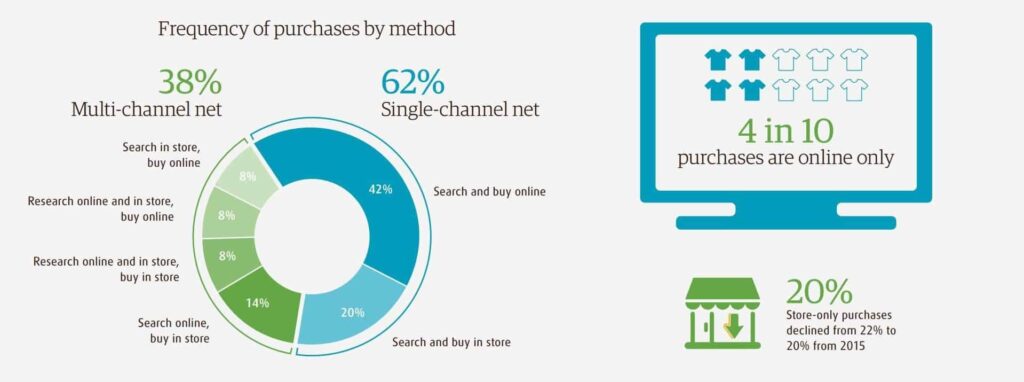By now, you’ve probably heard of virtual reality (VR). You may have even seen it on the market, displayed and tested in electronic supercenters around the world. It’s available for you to buy already, and as of right now, it’s being used mostly for entertainment. But VR has a future far beyond providing gamers with private stadiums and virtual starships inside their homes. So, what exactly does virtual reality mean for everyday consumers and the companies that seek to provide for them?
VR and AR Give Consumers Big Options and More Slack
Until now, consumers have been limited by how they purchase. You can either go to the store and pick out what you want, or you can take a risk and buy it online. The non-physical presence in a retail store doesn’t prevent you from making a purchase, but it does limit the satisfaction in the sense that it lacks certainty. Think about how many times you’ve been disappointed with a blouse you’ve bought online or from a magazine. You make a purchase thinking it will be a good one, but sometimes, vision is limited and foresight lacking.

Virtual reality and augmented reality (AR) have the power to stop this from happening by wiping out this system of chance. Once this technology goes mainstream, you won’t have to worry about buying the wrong fit for yourself. You’ll be able to pop on your VR headset and try those clothes on for size. In the comfort of your living room.
In-store retail experiences will change drastically as well, especially in the home-improvement categories. Imagine being able to see what that new coat of paint will look like in your living room or those new granite countertops. Virtual reality will allow you to walk through your home or one you’re planning to buy with new paint on the walls and furniture you’ve never seen before.
With the touch of a button, you’ll walk the halls of nonexistent wings of a part of a house you might build (think AutoCAD, but instantaneous and bursting with realism), making your vision a reality. A virtual one, at least. But one that feels so real you may be tempted to sit down on that virtual couch and put your feet up.
Augmented Reality will allow you to do this from your phone, says Gizmodo Field Guide. And a mixture of the two might provide the consumer experience that will propel us into the future faster than theoretical flying cars.

Don’t like that sky-blue color paint for the kitchen? That’s fine because you can press a button and see your home in canary yellow. Or rustic brown. Or any combination of colors the store has to offer. There are companies working day and night to make VR and AR experiences a reality for everyday consumers and the companies that cater to them.
The Future of the Entertainment Industry
Entertainment will change drastically with the integration of VR technology into our everyday lives. But with access to virtual reality, will larger-than-life experiences like movie theaters become obsolete?
It’s a possibility. With the introduction of VR, you’ll be able to sit in a movie theater right in your living room — even if you live in a studio apartment. And once consumers have this option, it’s likely the demand for movie theaters will drop.
VR technology may also give rise to other aspects of the entertainment industry we’ve never dreamed of before. Until now, only the rich could afford a vacation to the French Alps to snowboard. But it’s possible that VR could make skiing on a snow-covered mountain or scuba-diving in the Caribbean a reality for those that could previously only dream of such an experience. VR vacations are the next logical step of an altered reality experience.
Caption: A virtual reality vacation experience offered up by Qantas, Samsung and Hamilton Island.
Your movies and vacations won’t be the only experiences affected by VR technology. Now, poker players will be able to experience online gaming in a whole new light. VR casinos are coming soon, and they’ll allow players to be connected face-to-face from afar. The lights, the action, the roll of the dice — everything will be at your fingertips from the comfort of home.

Caption: A virtual reality poker table, ready to seat players from all over the world in the same virtual room for gameplay.
Even the experience of a brick-and-mortar casino will change with VR. Newbies will be able to learn rules and even play a few “real-life” games on the VR set before going to the actual table. “VR lounges” wherein clients can sit and play virtual poker are a real possibility as well.
Esports has become more and more popular over the years, and it’s possible that virtual reality will change the industry. VR has already come to enhance a more in-depth way to play your favorite games. It’s one thing to stare at a screen, but quite another to be inside a game.
Once you’ve experienced the latter, the first is bound to hold less appeal. And this technology is already starting to take over. In 2017, we saw the first national VR gaming tournament to date, and these sorts of events will only get bigger and become more prevalent. The technology and experience are so different (and arguably, better) that it’s taking the world by storm.
Remember how nobody thought we’d ever had household computers? That turned out to be resoundingly wrong. Now many people have two or three. It’s only a matter of time before VR and AR technology is common retail and household presence for people of all ages and incomes.


